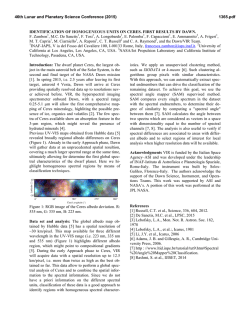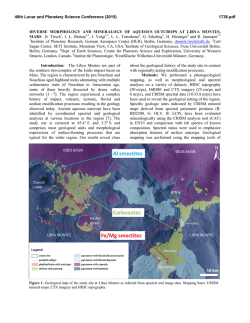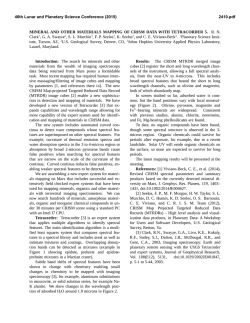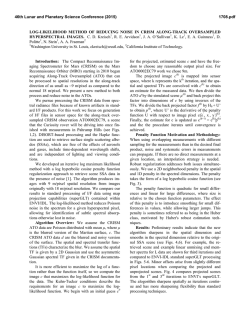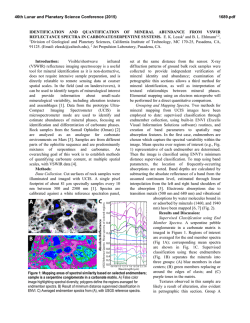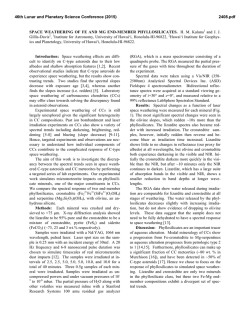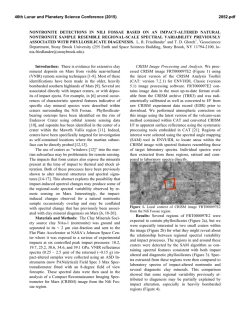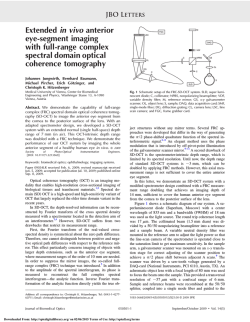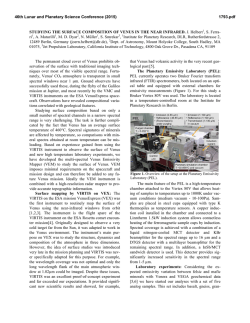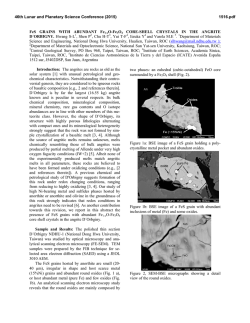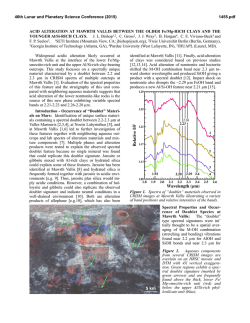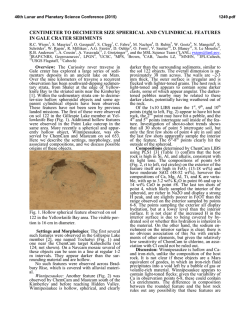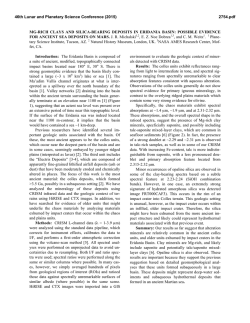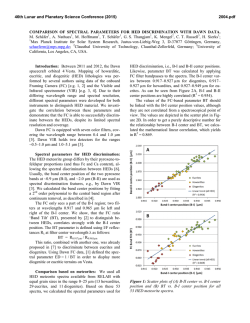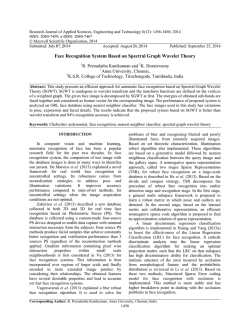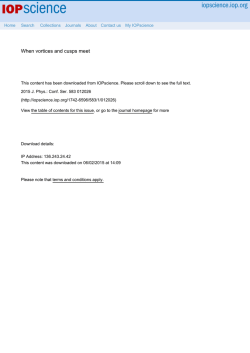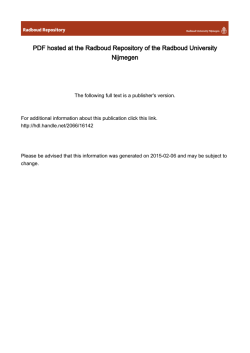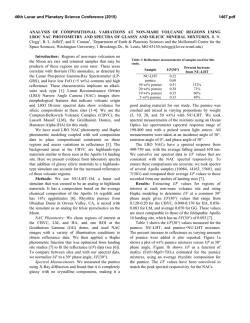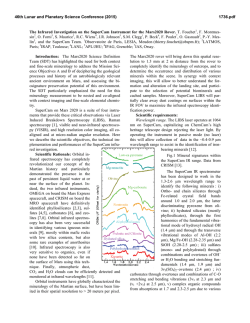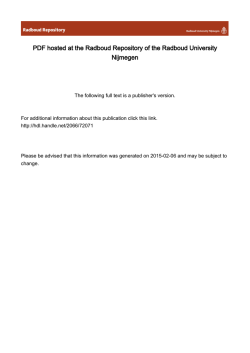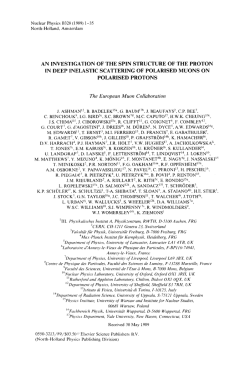
Photoconductivity and the structural phase transition in SrTiO3
Solid State Communications 141 (2007) 95–98 www.elsevier.com/locate/ssc Photoconductivity and the structural phase transition in SrTiO3 F. Rossella a,∗ , P. Galinetto a , G. Samoggia a , V. Trepakov b,c , L. Jastrabik b a Dipartimento di F´ısica “A. Volta”, Universit`a di Pavia, CNISM-1-27100 Pavia, Italy b Institute of Physics, AS CR, Na Slovance 2, 182 21, Prague 8, Czech Republic c A. F. Ioffe Physical-Technical Institute, 194 021, St.-Petersburg, Russia Received 11 May 2006; received in revised form 2 August 2006; accepted 1 September 2006 by J.W.P. Hsu Available online 20 September 2006 Abstract Detailed photoconductivity measurements have been performed in nominally pure SrTiO3 in order to elucidate the effect of the antiferrodistorsive cubic–tetragonal phase transition. Small features in the photoconductivity’s temperature dependence in the phase transition region were found using low intensity interband UV or 514 nm light illumination. Such features are associated with a transformation of the defect system controlling the photoconductivity. At the same time, the temperature behavior of the photoconductivity spectral maximum reveals a rather unusual feature which is connected with changes in the absorption band edge structure in the phase transition region. c 2006 Elsevier Ltd. All rights reserved. PACS: 72.20.i; 72.40.+w; 72.80.sk Keywords: A. Insulators; D. Photoconductivity and phase transitions; E. Photo-transport measurements 1. Introduction Perovskite quantum paraelectric SrTiO3 (STO) undergoes 18 antiferrodistortive (AFD) cubic–tetragonal structural Oh1 –D4h phase transition (PT) with Tc ∼ 105 K. Its dielectric constant increases on cooling implying ferroelectric instability at lowest temperatures. Recent new intriguing findings in STO, e.g. 18 O isotope exchange effect [1], reproducible switching in the leakage current in thin films [2], giant photoconductivity (PC) [3], and photo-dielectric effect [4,5] as well as reversible laser irradiation-induced photoluminescence changes [6], stimulate new efforts to deepen the knowledge of STO’s basic properties, especially concerning the conduction mechanisms in connection with structural and photo-induced phenomena. In particular, the effect of AFD PT on photogenerated carrier transport is still under debate, which has been studied, up to now, mostly in doped or reduced conductive specimens. A few papers dealing with nominally pure STO ∗ Corresponding address: Dipartimento di Fisica “A. Volta”, Universit`a di Pavia, Via Bassi 6, 27100 Pavia, Italy. Tel.: +39 0382 987 682; fax: +39 0382 987 563. E-mail address: [email protected] (F. Rossella). c 2006 Elsevier Ltd. All rights reserved. 0038-1098/$ - see front matter doi:10.1016/j.ssc.2006.09.006 gave contradictory results [7–10]. Indeed, a pronounced PC temperature maximum in the PT region was reported in [7] and associated with an increase of photo-carrier lifetimes and the appearance below Tc of new recombination levels. Nevertheless, the existence of this maximum was not confirmed in any further work. Minor or not significant changes of the PC temperature dependence in the PT region were reported in [9–11]. Besides, a narrow intense peak in the excitation spectrum of PC at energies slightly lower than the fundamental absorption edge was reported [9]. In an effort to explain these phenomena different new mechanisms have been proposed, e.g. an active role of the structural changes on the carrier mobility [3] and of domain boundaries formed below Tc [12]. As a result, different authors using different crystals, sample geometries and experimental conditions have reported controversial observations on PC features in the PT region for nominally pure STO. In order to bring new insight in this problem we undertook systematic investigations of spectral and temperature dependence of PC in nominally pure STO. We focused our attention on the AFD PT region, using various excitation light energies and intensities. In order to take into account possible surface and domain wall contributions, planar and sandwich electrodes as well as mono and poly-domain specimens below Tc were studied. 96 F. Rossella et al. / Solid State Communications 141 (2007) 95–98 Fig. 1. Photo-current density JPC vs. temperature (cooling rate 3 K/min) under broad-band UV light peaked at 370 nm. Curves 1, 2 and 3, taken illuminating with the same light intensity, refer respectively to bulk current measured by sandwich electrode geometry in poly-domain (Ps ) and mono-domain (Ms ) samples, and to surface current measured by surface planar electrodes in monodomain (M p ) sample. We used the symbols and to show the behaviour of curves 2 and 3 in the whole range. 2. Experimental details Transparent colorless nominally pure single crystals were grown by the Verneuil technique and annealed in oxygen atmosphere at around 1950 ◦ C. The impurity content was less than 15 ppm of Mg, Si, Al, Fe, Zn, Ni and Cr, as determined by atomic absorption spectroscopy and X-ray fluorescent analysis. The specimens were prepared in form of polished plates of 2.45 × 4.25 × 0.8 mm3 size. To study the possible influence of domain boundaries, both poly-domain (P sample) and monodomain (M sample) below Tc specimens prepared according to [13] were used. The P sample has two faces oriented along [100] principal cubic axes and the others randomly oriented; the faces of the M sample were oriented along [100], [110] and [110] cubic directions. Silver paint electrodes were deposited on two opposite faces (sandwich geometry) for bulk current measurements while surface planar electrodes where used to evaluate the surface current contribution. The samples were mounted into a He closed-cycle refrigerator system allowing measurements in the 15–300 K temperature region. PC was measured applying a driving electric field of ∼100 kV/m by a Keithley 6517 electrometer with ∼0.2 pA sensitivity. A XBO 75 W lamp coupled to interference filters or a Jobin Yvon monochromator (bandpass of ∼5 nm), as well as an Arlaser were used as photo-excitation sources. The PC excitation spectra were normalized for equal photon number at each energy. 3. Results and discussion The dark conductivity at RT was of the order of 10−14 −1 cm−1 and 10−12 −1 cm−1 for M and P samples respectively. This can be associated with the better quality of the M specimen. However, in any case the concentration of dark free carriers is negligible in comparison with that of photogenerated carriers. Fig. 2. Temperature dependence of the photo-current IPC for the mono-domain sample in sandwich configuration (M S ) measured at relative illumination intensities of 1, 3 and 100 under UV light (a) and of 1, 10 and 100 under laser light at 514.5 nm (b) irradiation. Fig. 1 presents the temperature dependence of photo-current density JPC induced by UV-light (370 nm) for poly-domain and mono-domain below Tc specimens with planar (M P ) and sandwich (M S , PS ) electrodes. PC increases on cooling, as is well known for SrTiO3 and usually attributed to carrier mobility behavior. The increase is smoother for P samples. In M samples the PC sharply increases around 35 K and our estimation for the activation energy of quenching centers yields ∼100 meV which is less than that obtained in [9]. The difference in the PC magnitude between M and P samples vanishes at lowest T where PC reaches nearly the same value in all examined cases. PC curves for M S and M P samples are nearly the same, evidencing the minor role of the surface contribution. The ratio between photo-current values at RT and at lowest T was ∼103 for the P sample and ∼104 for the M sample. The corresponding photo-resistivity reaches ∼108 cm at the lowest temperatures. In Fig. 1 no features in the PC around 105 K are observed which could be associated with the AFD PT. Fig. 2 shows PC temperature dependence for the M S configuration, i.e. the mono-domain sample with surface electrodes configuration, measured at three different UV (Fig. 2(a)) and visible (Fig. 2(b)) light intensities. It is remarkable that under UV light, a faint but evident feature appears in the PT region at low excitation intensities, i.e. at small photo-carrier concentration. Under excitation at 514.5 nm a pronounced wide smooth PC temperature maximum appears for each intensity. Such behavior can be qualitatively explained as follows. In the case of UV excitation, photo-carriers are generated in the surface layer and the PC is controlled by recombination rate of photo-electrons and holes due to their high density, so that no strong features in the PT region are expected. However, under 514.5 nm light excitation, photo-carrier generation takes place in the bulk and is followed by complex trapping, charge release, re-trapping and charge transfer processes before photoelectrons and holes recombine. In such a case impurity levels and traps control carrier drift and recombination processes, and changes in the defect system in the PT region lead to the F. Rossella et al. / Solid State Communications 141 (2007) 95–98 Fig. 3. Stationary PC excitation spectrum () in the 2–5 eV spectral region at 70 K, treated in order to be compared with absorption coefficient (α) data (N) at 82 K reported in [14]. Fig. 4. Stationary photo-current IPC excitation spectra in the 2.4–4.4 eV spectral region, at different temperatures. appearance of the PC feature, as considered in [7]. A similar situation can be realized under weak UV excitation and low photo-induced carrier concentration conditions. Fig. 3 shows the stationary PC excitation spectrum in the 2–5 eV spectral region measured at 70 K. Steady state conditions were reached after a long time so we used an interpolation procedure in order to obtain the stationary PC value from the time evolution of the signal. The spectrum has a conventional shape revealing three different spectral regions. The PC excited in the region 2–3 eV, i.e. less than band-gap, is attributed to generation of carriers photo-excited from defect levels. A sharp onset of PC at ∼3.14 eV due to the band-gap was observed, but in contrast with observations reported in [9] we didn’t reveal any anomalous PC narrow maximum in the fundamental absorption region. The sharp rising PC in the region 3.2–3.34 eV is controlled by absorption coefficient spectral behavior. At higher energies a wide PC spectral maximum (FWHM ∼ 0.71 eV between 3.27 and 3.98 eV) emerges, followed by a PC decrease ascribed to the increase of absorption coefficient and surface recombination mechanisms [15]. Fig. 4 shows PC excitation spectra collected at different temperatures. The general features remain the same at all 97 Fig. 5. Spectral position of the PC maxima at different temperatures (inset shows Lytle data [16] for lattice constant, see text). temperatures. In accordance with results discussed above, PC increases nearly three orders of magnitude in cooling from RT to the lowest temperature. Fig. 5 presents the temperature dependence of the energy value of the PC spectral maximum. It is seen that cooling from RT to about 120 K the position of the PC spectral maximum shifts to higher energies, passing from ∼3.60 eV to ∼3.66 eV at 120 K, with a thermal shift coefficient ∼3×10−4 eV/K. This is practically the same as the value reported by Feng in connection with the observed “anomalous maximum” [9], although the positions of maxima were different (3.26 eV at RT and 3.35 eV at 100 K). At around 120 K, the energy value of the PC peak reaches a maximum. Such behavior, in particular the decrease of the PC spectral maximum position on cooling under 120 K, is a very surprising result. Generally the PC reaches a maximum in the region of the band-gap edge and its position often is used for band-gap magnitude estimation. So, the trend shown in Fig. 5 above 120 K is a conventional one. To our mind, the maximum around 120 K is connected with the AFD phase transition while the PC decrease just below the AFD PT point can be connected with two circumstances. First, we note that the absorption edge in STO in cubic phase is caused by indirect M → Γ interband BE-optical transitions with 55 meV LO phonon absorption (3.6 eV), which probably forms the PC spectral maximum too. Weak R → Γ indirect optical Atransitions in the region ∼3.3 eV do not play an important role in the PC excitation spectral maximum formation [16,17]. 18 cubic–tetragonal PT is controlled by However, Oh1 → D4h TO phonon mode softening at the R-point of Brillouin zone; below PT, the R point merges with the Γ one, and the unit cell duplicates. In such a case more effective Γ → Γ optical transitions start to control the PC at the band edge region. This can induce an appreciable shift of PC spectral maximum to the lowest energies, as we observed in our experiment. In addition, the specificity of the temperature dependence of the lattice parameter for STO (see inset in Fig. 5) reported by Lytle [18] can also contribute to the observed maximum. The lattice behavior can promote not only the appearance of the local maximum in the temperature dependence of the the PC spectral maximum position, but also the shift of this position 98 F. Rossella et al. / Solid State Communications 141 (2007) 95–98 to lower energies below the PT point. At the same time, it should be remarked that the PC spectral maximum in STO appears to be rather wide and the temperature shift takes place practically inside of this wide maximum. In such a case the temperature behavior of the PC spectral maximum position below the AFD PT point can originates from continuing oxygen octahedra rotation (PT order parameter), lattice parameter change, complex variations of hierarchy of the optical transition controlling optical band edge and photo-carrier lifetime in the surface layers. optical transitions transform into direct Γ → Γ ones leading to a significantly lower energy shift of the PC spectral maximum. Contributions to such behavior came also from the unusual temperature dependence of the lattice parameter below AFD PT. 4. Conclusions References In this work we presented detailed experimental study of PC in highly resistive nominally pure SrTiO3 single crystals within the 15–300 K temperature range and the 2–5 eV spectral range. The main attention was focused on the influence of the AFD PT on photo-carrier transport properties. Poly-domain and mono-domain below PT samples, as well surface and sandwich type electrodes, were used in order to take into account domain wall and surface contributions. The study of the PC temperature dependence indicate that PC is practically not influenced by surface and domain wall contributions, and in particular the PT plays a minor role in the photo-transport phenomena. At the same time, under weak UV interband excitation and under excitation by visible light, weak and wide temperature maxima emerge. Such behavior is associated with the transformation of impurity levels controlling photo-charges which takes place in the PT region. At the same time structural transformations accompanying the AFD PT influence the PC spectral maximum position, with a maximum energy of 3.66 eV in the PT region. Such unusual behavior is connected with band structure transformations accompanying the AFD PT in STO. In the cubic phase the position of the PC spectral maximum is controlled by indirect M → Γ optical transitions and the less energetic R → Γ transitions play a minor role. The R point merges with the Γ point of the BZ at the PT, and indirect Acknowledgements This work was supported by Grants RFBR 06-02-17320, AV ˇ AV0Z 10100522 and Italian Grant FIRB RBNE01KZ94. CR [1] M. Itoh, R. Wang, Y. Inaguma, T. Yamaguchi, Y-J. Shan, T. Nakamura, Phys. Rev. Lett. 82 (1999) 3540. [2] A. Beck, J.G. Bednorz, Ch. Geber, C. Roseel, D. Widmer, Appl. Phys. Lett. 77 (2000) 139. [3] H. Katsu, H. Tanaka, T. Kawai, Japan J. Appl. Phys. 39 (2000) 2657. [4] M. Takesada, T. Yagi, M. Itoh, S.-Y. Koshihara, J. Phys. Soc. Japan 72 (2003) 37. [5] T. Hasegava, S. Moury, Y. Yamanaka, K. Tanaka, J. Phys. Soc. Japan 72 (2003) 41. [6] S. Mochisuki, F. Fujishiro, S. Minami, J. Phys.: Condens. Matter 17 (2005) 923. [7] J.T. Sihvonen, J. Appl. Phys. 38 (1967) 4431. [8] A.L. Kholkin, E.V. Kuchis, V.A. Trepakov, Ferroelectrics 83 (1988) 135. [9] T. Feng, Phys. Rev. B. 25 (1982) 627. [10] T. Hasegava, S. Moury, Y. Yamanaka, K. Tanaka, J. Luminescence 87–89 (2000) 1217. [11] A.L. Kholkin, Ph.D. Thesis, A.F Ioffe Physical–Technical Institute, St.-Petersburg, 1988, p. 81. [12] Y. Yasunaga, I. Nakada, J. Phys. Soc. Japan 22 (1967) 338. [13] K.A. Mueller, W. Berlinger, M. Capizzi, H. Granicher, Solid State Commun. 8 (1970) 549. [14] M. Capizzi, A. Frova, Phys. Rev. Lett. 25 (1970) 1298. [15] R. Bube, Photoconductivity of Solids, J. Wiley and Sons Inc, New York, London, 1960, p. 390. [16] S.I. Shablaev, A.M. Danishevskii, V.K Subashiev, Fizika Tverdogo Tela 26 (1984) 179. [17] S.I. Shablaev, A.M. Danishevskii, V.K. Subashiev, ZhETP 86 (1984) 2158. [18] F.W. Lytle, J. Appl. Phys. 35 (1964) 2212.
© Copyright 2026
